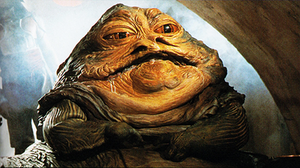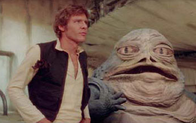Jabba the Hutt facts for kids
Quick facts for kids Jabba the Hutt |
|
|---|---|
| Star Wars character | |

Jabba the Hutt as seen in Return of the Jedi (1983).
|
|
| First appearance |
|
| Created by | George Lucas |
| Portrayed by | Declan Mulholland (Episode IV; deleted scene, later restored and overlapped with CGI for 1997 Special Edition and subsequent releases) |
| Voiced by |
Other:
|
| Performed by | David Barclay / Toby Philpott / Mike Edmonds (Episode VI) |
| Language | Huttese |
| Information | |
| Species | Hutt |
| Gender | Male |
| Occupation | Crime lord |
| Family |
|
| Children | Rotta the Hutt (son) |
| Homeworld | Nal Hutta |
Jabba Desilijic Tiure, more commonly known as Jabba the Hutt, is a fictional character and minor antagonist in the Star Wars franchise. Created by George Lucas, Jabba is voiced by Larry Ward with several puppeteers inside a one-ton puppet portraying him in Return of the Jedi. He was originally supposed to first appear in Star Wars (1977) as a stop motion character with Declan Mulholland as his stand-in. Jabba was later added into the film as a CGI character when it was re-released in Special Edition in 1997. He also appears in the prequel movie The Phantom Menace. The character is a large slug-like creature based on annelid worms and originally designed as an apelike figure.
In the films, Jabba is a powerful crime lord on the planet Tatooine, who is of the Hutt species. His name has entered common parlance as being synonymous with negative qualities such as morbid obesity, corruption, and corporate greed.
Production, and design
Designed by visual effects artist Phil Tippett, Jabba the Hutt was inspired by the anatomy of several animal species. His body structure and reproductive processes were based on annelid worms, a hairless animal that has no skeleton and are hermaphroditic. Jabba's head was modeled after that of a snake, complete with bulbous, slit-pupilled eyes and a mouth that opens wide enough to swallow large prey. Moist, amphibian qualities were given to his skin. Jabba's design would come to represent almost all members of the Hutt species in subsequent Star Wars fiction.
In Return of the Jedi, Jabba is portrayed by a one-ton puppet that took three months and half a million dollars to construct. While filming the movie, the puppet had its own makeup artist. The puppet required three puppeteers to operate, making it one of the largest ever used in a motion picture. Stuart Freeborn designed the puppet, while John Coppinger sculpted its latex, clay, and foam pieces. The puppeteers included David Alan Barclay, Toby Philpott, and Mike Edmonds, who were members of Jim Henson's Muppet group. Barclay operated the right arm and mouth and read the character's English dialogue, while Philpott controlled the left arm, head, and tongue. The eyes and facial expressions were operated by radio control.
Lucas voiced displeasure in the puppet's appearance and immobility, complaining that the puppet had to be moved around the set to film different scenes. In the DVD commentary to the Special Edition of Return of the Jedi, Lucas notes that, if the technology had been available in 1983, Jabba the Hutt would have been a CGI character similar to the one that appears in the Special Edition scene of A New Hope.
Jabba the Hutt only speaks Huttese on film, but his lines are subtitled in English. His voice and Huttese-language dialogue were performed by the uncredited voice of Larry Ward. A heavy, booming quality was given to Ward's voice by pitching it an octave lower than normal and processing it through a subharmonic generator. A soundtrack of wet, slimy sound effects was recorded to accompany the movement of the puppet's limbs and mouth.
Jabba the Hutt's musical theme throughout the film, composed by John Williams, is played on a tuba. The theme is very similar to one which Williams wrote for a heavyset character in Fitzwilly (1967), though the theme does not appear on that film's soundtrack album. Williams later turned the theme into a symphonic piece performed by the Boston Pops Orchestra featuring a tuba solo by Chester Schmitz. The role of the piece in film and popular culture has become a focus of study by musicologists such as Gerald Sloan, who says that Williams' piece "blends the monstrous and the lyrical."
Images for kids
See also
 In Spanish: Jabba el Hutt para niños
In Spanish: Jabba el Hutt para niños







